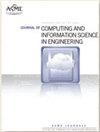Metacomputing for Directly Computable Multiphysics Models
IF 3.3
3区 工程技术
Q2 COMPUTER SCIENCE, INTERDISCIPLINARY APPLICATIONS
Journal of Computing and Information Science in Engineering
Pub Date : 2023-08-04
DOI:10.1115/1.4063103
引用次数: 0
Abstract
The ever-improving advances of computational technologies have forced the user to manage higher resource complexity and motivates the modeling of more complex multiphysics systems than before. Consequently, the time for the user's iterations within the context space characterizing all choices required for a successful computation far exceeds the time required for the runtime software execution to produce acceptable results. This paper presents metacomputing as an approach to address this issue, starting with describing this high-dimensional context space. Then it highlights the abstract process of multiphysics model generation/solution and proposes performing top-down and bottom-up metacomputing. In the top-down approach, metacomputing is used for: Automating the process of generating theories; Raising the semantic dimensionality of these theories in higher dimensional algebraic systems that enable simplification of the equational representation and raising the syntactic dimensionality of equational representation from 1-D equational forms to 2-D and 3-D algebraic solution graphs that reduce solving to path-following. In the bottom-up approach, already existing legacy codes evolving over multiple decades are encapsulated at the bottom layer of a multilayer semantic framework that utilizes Category Theory based operations on specifications to enable the user to spend time only for defining the physics of the relevant problem and not have to deal with the rest of the details involved in deploying and executing the solution of the problem at hand. Consequently, these two metacomputing approaches enable the generation, composition, deployment, and execution of directly computable multiphysics models.直接可计算多物理模型的元计算
计算技术的不断进步迫使用户管理更高的资源复杂性,并激发了比以前更复杂的多物理场系统的建模。因此,用户在上下文空间中描述成功计算所需的所有选择的迭代时间远远超过运行时软件执行产生可接受结果所需的时间。本文提出元计算作为解决这个问题的一种方法,从描述这个高维上下文空间开始。然后重点介绍了多物理场模型生成/求解的抽象过程,提出了自顶向下和自底向上的元计算方法。在自顶向下的方法中,元计算用于:自动化生成理论的过程;提高这些理论在高维代数系统中的语义维度,使等式表示能够简化,并将等式表示的语法维度从一维方程形式提高到二维和三维代数解图,从而减少求解路径跟踪。在自底向上的方法中,已经存在的经过几十年演进的遗留代码被封装在多层语义框架的底层,该框架利用基于规范的范畴论操作,使用户只需花时间定义相关问题的物理特性,而不必处理部署和执行手头问题解决方案所涉及的其余细节。因此,这两种元计算方法支持直接可计算的多物理场模型的生成、组合、部署和执行。
本文章由计算机程序翻译,如有差异,请以英文原文为准。
求助全文
约1分钟内获得全文
求助全文
来源期刊
CiteScore
6.30
自引率
12.90%
发文量
100
审稿时长
6 months
期刊介绍:
The ASME Journal of Computing and Information Science in Engineering (JCISE) publishes articles related to Algorithms, Computational Methods, Computing Infrastructure, Computer-Interpretable Representations, Human-Computer Interfaces, Information Science, and/or System Architectures that aim to improve some aspect of product and system lifecycle (e.g., design, manufacturing, operation, maintenance, disposal, recycling etc.). Applications considered in JCISE manuscripts should be relevant to the mechanical engineering discipline. Papers can be focused on fundamental research leading to new methods, or adaptation of existing methods for new applications.
Scope: Advanced Computing Infrastructure; Artificial Intelligence; Big Data and Analytics; Collaborative Design; Computer Aided Design; Computer Aided Engineering; Computer Aided Manufacturing; Computational Foundations for Additive Manufacturing; Computational Foundations for Engineering Optimization; Computational Geometry; Computational Metrology; Computational Synthesis; Conceptual Design; Cybermanufacturing; Cyber Physical Security for Factories; Cyber Physical System Design and Operation; Data-Driven Engineering Applications; Engineering Informatics; Geometric Reasoning; GPU Computing for Design and Manufacturing; Human Computer Interfaces/Interactions; Industrial Internet of Things; Knowledge Engineering; Information Management; Inverse Methods for Engineering Applications; Machine Learning for Engineering Applications; Manufacturing Planning; Manufacturing Automation; Model-based Systems Engineering; Multiphysics Modeling and Simulation; Multiscale Modeling and Simulation; Multidisciplinary Optimization; Physics-Based Simulations; Process Modeling for Engineering Applications; Qualification, Verification and Validation of Computational Models; Symbolic Computing for Engineering Applications; Tolerance Modeling; Topology and Shape Optimization; Virtual and Augmented Reality Environments; Virtual Prototyping

 求助内容:
求助内容: 应助结果提醒方式:
应助结果提醒方式:


